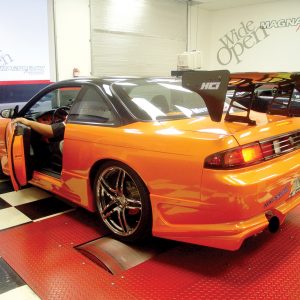Hot Rods
As 40-somethings ourselves, we know how it is to get, shall we say, tired and worn out. And when the owner of this ’64 Nova figured that age had done its worst to the steering system of his car, it was time to replace it.
Okay, we weren’t quite that naive about what we read regarding upgrading to 1.6 rockers on our small-block Chevy for the first time, but it was close.
The engine in question was a decent runner with 30,000 miles on the mild-performance rebuild. The rebuilt engine was purchased used, and among its selling points were 0.030-over 9.5:1 pistons, moly rings, 1.5 roller rockers, a Performer RPM intake and a brand-new Holley 750cfm carburetor. The cam wasn’t a perfect match to the torque converter used in the previous installation nor was the final-drive gear ratio. As a result, the owner planned on stepping down on the cam chart to a Comp 286H-10 cam, which came with the engine in its original box. Also included were a brand-new factory Z28 oil pan and a factory timing chain cover to replace the cheap chrome pieces. For $300, the engine package was a deal, and one we couldn’t pass up. We sold the aforementioned chrome pieces and matching valve covers for $50, getting us the engine at the bargain price of $250, and we still had the new cam and lifters on our shelf.
Unscrupulous Swap Meet Hawks Are Peddling (for More Money) 2.00-inch Ramʼs Horn Manifolds for the Bigger 2.50-Inch Design.
Now that the typical Chevy buildup cars (Novas, Camaros, El Caminos, Chevelles and so forth) are well over 30 years old, most have had several owners and lots of abuse. One important yet often overlooked area during a car’s lifetime is its locks, and by now, most early Chevys have mismatched or missing keys. Some don’t even have any keys or locks when you buy them. If you do find a car that still has its original keys, it is very unusual.
Cam-speak is a language all its own. Well, maybe not from a linguistic point of view, but it is a specialized dialect of car-guy talk. Although spoken by a good portion of enthusiasts, Cam-speak is really fully understood by only a handful of those same enthusiasts, as it is a very specialized, nuanced dialect.
In the eyes of the Chevy enthusiast, ultimate acceleration reigns supreme. Everything plays second fiddle in the performance-oriented minds of many enthusiasts, including handling, comfort and so on—besides, those things are tough to quantify. Acceleration and top speed are what we are into and unfortunately, all too often, last on the performance priority list is braking. Remember, no matter how quick or fast a particular Chevy is, and no matter how well that Bow Tie handles, no matter how plush it is, no matter how straight the body panels are or how crafty it’s built, eventually you have to get the thing to stop.
Hundreds of thousands of these “little” big-blocks were sold in the 1960s. In 1965-66 alone, over 150,000 came in the Impala, Biscayne and Bel Air big cars. Few paid attention to them because the hot engine of the day was the L-78 with high-rpm, rectangle-port heads. But when stock eliminator drag racers began flogging the L-35, it responded magnificently.
What makes more power: carburetors or computers? While the ultimate answer is that a sophisticated electronic fuel-injection system will virtually always outpower a carburetor, the real question may be whether the power gains are worth the extra expense and complexity of installing an EFI system.
You can drive this bad boy coast to coast and burn all the rubber you want in between.” That was Day Automotive’s Tony Shaffer proclaiming the abilities of his shop’s 482/409. Soon thereafter, we were entering the confines of Day Automotive in Independence, Missouri, where Shaffer and crew had just completed the engine in seven days. It represents what can be accomplished power-wise with the right combination of parts, plus some internal modifications. And with a 10.0:1-compression ratio, it’s very street-friendly.







